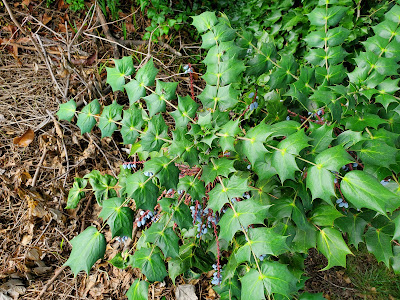Over the weekend, Shira and I were walking down a section of Columbia Pike we've traversed hundreds, if not thousands of times and I noticed something new. This plant:
The leaves were holly-like, but the symmetry, red tentacles and clumps of berries made for a Seussian look that stopped me in tracks.
I had questions!
What's it called? It's a Leatherleaf mahonia, aka Mahonia beali, aka Berberis bealei. (Thanks Google Lens)
Is it rare? Nope, not at all. In many Southeastern States in the US it's considered invasive.
Can you eat the berries? You can! I haven't tried them yet, though.
Does it have any medicinal uses? It does! You can make a decoction from the plant, which can be used as an antibiotic.
For me, the most interesting question turned out to be: how did this plant get here?
I'm not talking about how it came to arrive on Columbia Pike. Given that this plant can be invasive, and has a reputation for being distributed via bird-poop (now there's a distribution strategy!), it's not a surprise that it would show up in the area. In fact, the interesting part is less about how, and more about who.
It was this post that tipped me off to this background, so full credit belongs there.
The who in this case is Robert Fortune, a man who's name matches his exploits. Fortune was part botanist, part thief and part spy. His adventures involved traveling through China and nicking plants and expertise. His greatest exploit was smuggling tea plants and manufacturing knowledge out of China, thereby giving Britain the raw materials and know-how to launch their own tea industry. This feat has been called the greatest single act of corporate espionage in history.
The story behind the leatherleaf isn't quite as dramatic. SAR Craft explains:
The story goes that Fortune saw a plant of interest growing inside the walled garden of a Chinese nobleman in Peking. He waited until the nobleman had left on a trip, climbed the wall, yanked the plant out of the ground, and snuck it back to Shanghai, where he named it after his patron: Mahonia beali. From there, it grew popular with both British and American gardeners... it never naturalized in Britain (probably too cold), but it took off in the States.
Fortune wrote a number of books, many of which are easily and freely accessed online (including: Three Years' Wanderings in the Northern Provinces of China, A journey to the tea countries of China and A residence among the Chinese). I couldn't find any reference to the above story by searching these texts, but I did find this snippet in A Journey to the Tea Countries of China (page 81):
Having taken a survey of the place, we were making our way out, when an extraordinary plant, growing in a secluded part of the garden, met my eye. When I got near it I found that it was a very fine evergreen Berberis, belonging to the section of Mahonias, and having of course pinnated leaves. Each leaflet was as large as the leaf of an English holly, spiny, and of a fine dark, shining green colour. The shrub was about eight feet high, much branched, and far surpassed in beauty all the other known species of Mahonia. It had but one fault, and that was, that it was too large to move and bring away. I secured a leaf, however, and marked the spot where it grew , in order to secure some cuttings of it on my return from the interior.
This appears to be a description of him finding an example of the plant, not the original discovery. Still, it's delightful to read his words penned over 170 years ago and to be able to compare them to my introduction to this plant. It's a very fine evergreen indeed!



No comments:
Post a Comment